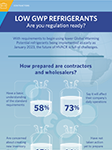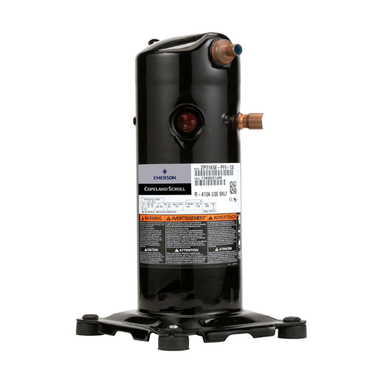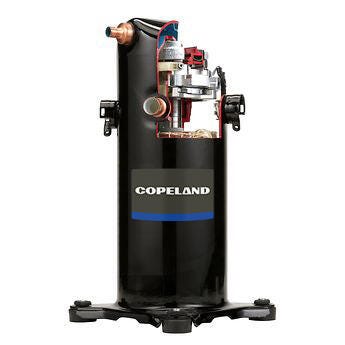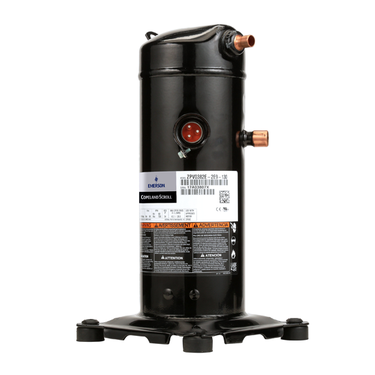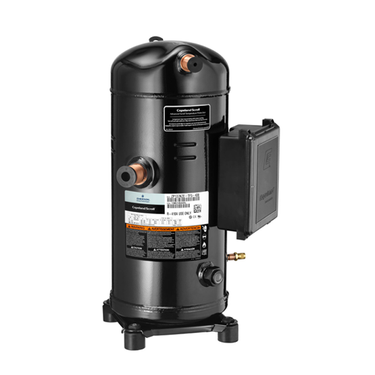The Latest in HVAC Efficiency and Refrigerant Regulatory Changes
The HVAC industry is preparing for the next round of refrigerant and efficiency regulations for air conditioning and heat pumps. Although the industry has a significant amount of experience in increasing efficiency and transitioning to new refrigerants, the timing and uncertainty have made this regulatory cycle more complex
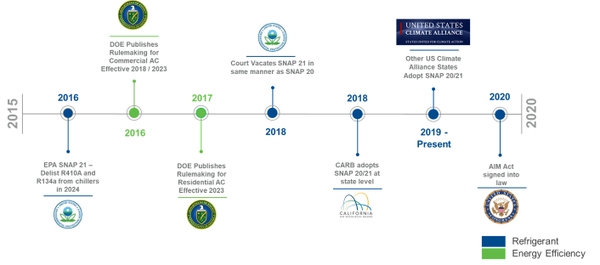
State and International Regulations Continue to Drive HFC Refrigerant Phase-Down
Environmental Protection Agency (EPA)
The EPA has faced challenges relative to regulating HFC refrigerants over the last five years. In 2016, they finalized the SNAP 21 rulemaking, making R410A and R134a unacceptable for use in positive displacement chillers as of Jan 1, 2024. Litigation ensued, challenging the EPA’s authority to regulate non-ozone-depleting substances under the Clean Air Act (CAA). In 2017, the court agreed with the plaintiffs and partially vacated the SNAP rules that required those users already moving out of ozone-depleting substances to shift again to lower-GWP refrigerants. In response to the 2017 court ruling, the EPA stated they would not enforce HFC provisions for SNAP 20/21 at the federal level and has rolled back other HFC-related regulations. In particular, they have excluded HFCs from the leak repair and maintenance requirements for stationary refrigeration equipment, otherwise known as Section 608 of the CAA.
The updated rule, which had been in effect since 2016, lowered the leak rate threshold in supermarket refrigeration systems from 35 percent to 20 percent and set forth specific requirements pertaining to HFC management. With the rescinding of this rule, refrigeration equipment with 50 pounds or more of HFC refrigerant would no longer be subject to these requirements.
Even if the leak repair and maintenance requirements of Section 608 are no longer enforced for HFC systems, an effective leak repair and maintenance program is still generally recognized as an industry best practice. Other beneficial provisions of Section 608 — including the certified technician program and the refrigerant recovery and reclamation rules — are still in effect.
California Air Resources Board (CARB)
In absence of regulatory certainty at the federal level, many states are adopting environmental regulations that seek to limit the negative impacts of short-lived climate pollutants (SLCP) such as HFCs. California was the first state to take official action. California Senate Bill 1383, also known as the Super Pollutant Reduction Act, was passed in 2016 and requires that Californians reduce F-gas emissions by 40 percent by 2030. Another related bill, California Senate Bill 1013 was signed into law in Sept. 2018. Referred to as the California Cooling Act, this law mandated the full adoption of SNAP Rules 20 and 21 as they read on January 3, 2017. The California Air Resources Board (CARB) published the adoption of SNAP Rules 20 and 21 as state regulation at the end of 2018.
To reach the 40 percent reductions required by 2030, CARB also proposed an aggressive second phase of rulemaking that will further impact AC applications. On December 10, 2020, the CARB board voted to approve the proposal, which includes the following requirements.
In air conditioning applications, the CARB proposal targets a 750 GWP limit across multiple end-uses in the coming years:
- 2023: room AC and dehumidifiers
- 2024: AC chillers (consistent with SNAP Rule 21)
- 2025: residential and commercial AC
- 2026: variable refrigerant flow (VRF) systems
CARB also introduced its Refrigerant Recycle, Recovery and Reuse (R4) program, which proposes new air conditioning equipment in 2023 and 2024 to use reclaimed R-410A refrigerant in an amount equal to 10% of equipment operating charge in California. It is anticipated the second round of rulemaking with conclude by the end of 2021 and a third round is likely to be introduced. CARB has stated that the third round will likely expand its R4 program and potentially identify requirements for additional end uses.
Other States Follow California’s Lead
With California taking a leadership role in environmental regulations, other U.S. Climate Alliance states have adopted a similar approach. The U.S. Climate Alliance, with a shared commitment to reducing SLCPs and HFCs, includes 24 states and Puerto Rico. Sixteen states have either adopted SNAP 20/21 into state law/regulation or are in the process of doing so.
To reduce the complexity of implementation, industry advocates, including the Air-conditioning Heating and Refrigeration Institute (AHRI) and the National Resources Defense Council (NRDC), have asked for states to be consistent in their approach to adopting CARB’s rules.
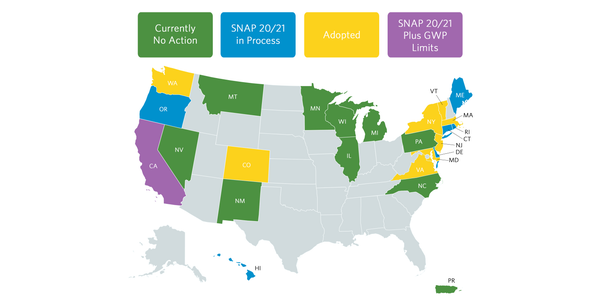
The Kigali Amendment to the Montreal Protocol
Although most associate the Montreal Protocol with phasing out ozone-depleting substances, it has also been evaluating the global warming potential of HFCs for over a decade. In 2016, 197 countries met in Kigali, Rwanda, and agreed on a global proposal to phase down HFCs. The Kigali Amendment required ratification from at least 20 countries to take effect. To date, 100+ countries (including the E.U. Member States, but not including the U.S.) have ratified it. As such, it took effect for participating countries on January 1, 2019. President Biden has announced his intention to send the Kigali Amendment to the Senate for ratification.
Federal HFC Legislation
As part of major pandemic relief legislation, the American Innovation & Manufacturing Act (AIM Act) was passed by Congress and signed into law in late 2020. This legislation grants the federal government the authority to phase down the production and consumption of HFCs in a manner consistent with the Kigali Amendment to the Montreal Protocol.
The AIM Act regulates HFCs in three ways:
- It gradually phases down the production and consumption of HFCs over a 15-year period via an allowance allocation program, similar to the way ozone-depleting substances were regulated under Title VI.
- It authorizes the EPA to establish standards for the management of HFCs used as refrigerants, such as in equipment servicing and repair, and for the recovery of “used” HFCs for purification and resale, also known as reclaim. This allows for a safe and efficient transition out of HFCs.
- It authorizes the EPA to establish sector-based use restrictions as a way to facilitate transitions to next-generation refrigerant technologies. These use restrictions would complement the broader HFC production and consumption phase-down, aiding sectors able to transition more quickly out of HFCs and providing additional flexibility for those sectors in need of more time to complete a transition.
This does not interfere with the use of HFCs in existing refrigeration and air conditioning equipment, i.e., consumers will not be forced to replace equipment before the end of its useful life.
Refrigerant Safety Standards & Codes
Meeting the targeted emissions reductions in California will require the use of lower-GWP refrigerants. But many of these low-GWP, hyrdrofluoroolefin (HFO), HFC, and HFO/HFC blend refrigerants are classified as A2L, or mildly flammable. Product and application standards, UL 60335-2-40 3rd edition and ASHRAE 15 have been updated for comfort cooling to define charge limits and mitigation required to limit the potential of a flammable event in case of a leak. Work on the 4th edition of UL 60335 2-40 is underway.
These standards will serve as the bases for codes that govern building, fire and other local authorities having jurisdiction (AHJ), who will ultimately oversee the applications in which these refrigerants are used. It’s important to remember that building codes vary from state to state; thus, the adoption of flammable refrigerants will take place on local levels and may take years to accomplish.
Federal Energy Efficiency Requirements Increasing in 2023
Energy Efficiency
The U.S. Department of Energy (DOE) has the authority to establish minimum efficiency standards for air conditioning and heat pump equipment. The next set of energy efficiency increases will impact both residential and commercial rooftop equipment.
- RESIDENTIAL
- COMMERCIAL
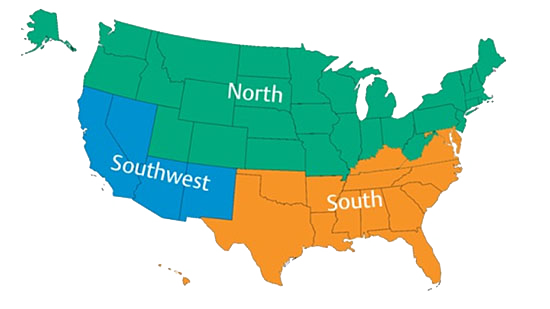
Residential Air Conditioning / Heat Pump Energy Efficiency Standards
The tables below show the minimums for residential air conditioning and heat pumps currently, and the new minimums taking effect in 2023. Along with the increase in efficiency, a new test procedure will also be entering into force: 10 CFR Appendix M1 to Subpart B of Part 430 - Uniform Test Method for Measuring the Energy Consumption of Central Air Conditioners and Heat Pumps. Systems tested for this method will use new nomenclature SEER2/HSPF2/EER2.
Because of the new test procedure, the increase in efficiency is not as transparent as in the past, but effectively there is a 1 SEER increase for both the north and south. To better correlate the old and new, the 2023 table below includes the new SEER2/HSPF2/EER2 and the equivalent SEER/HSPF/EER values in parenthesis.
Commercial Air Conditioning
Commercial rooftop efficiency is represented as Integrated Energy Efficiency Ratio (IEER). The 2023 federal minimum efficiency increase is roughly a 15% increase relative to the 2018 efficiency levels.
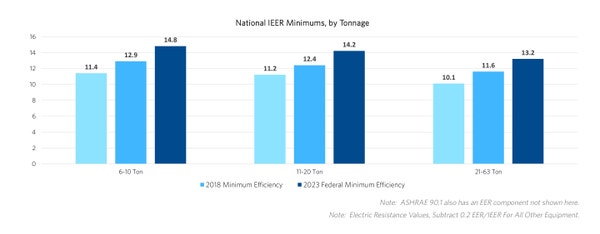
Minimums for Residential Air Conditioning and Heat Pumps
| Today – Appendix M | All | North | South | Southwest | |
|---|---|---|---|---|---|
| Type | HSPF | SEER | SEER | SEER | EER |
| AC | - | 13 | 14 | 14 | 12.2/11.7* |
| Heat Pump | 8.2 | 14 | 14 | 14 | - |
| Packaged Units | 8.0 | 14 | 14 | 14 | 11 |
| *11.7 EER limit for equipment ≥ 45K BTU/Hr |
| 2023 – Appendix M1 | All | North | South | Southwest | |
|---|---|---|---|---|---|
| Type | HSPF2 (HSPF) | SEER2 (SEER) | SEER2 (SEER) | SEER2 (SEER) | EER2 (EER) |
| AC < 45K BTU/Hr | - | 13.4 (14) | 14.3 (15) | 14.3 (15) | 11.7 (12.2) / 9.8* (10.2) |
| *NewAC > 45K BTU/Hr | - | 13.4 (14) | 13.8 (14.5) | 13.8 (14.5) | 11.7 (12.2) / 9.8* (10.2) |
| Heat Pump | 7.5 (8.8) | 14.3 (15) | 14.3 (15) | 14.3 (15) | - |
| Packaged Units | 6.7 (8.0) | 13.4 (14) | 13.4 (14) | 13.4 (14) | 10.6 (11) |
| *9.8 EER2 limit for equipment ≥ 15.2 SEER2 |
Air Conditioning Product Lineup
- RESIDENTIAL
- COMMERCIAL
Copeland Residential AC Solutions to Meet Efficiency Requirements
Copeland offers a variety of residential compressor solutions to help achieve upcoming efficiency requirements.
Copeland Commercial AC Solutions to Meet Efficiency Requirements
Copeland offers a variety of commercial compressor solutions to help achieve upcoming efficiency requirements.

